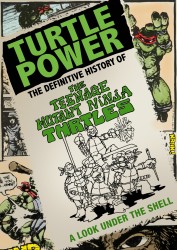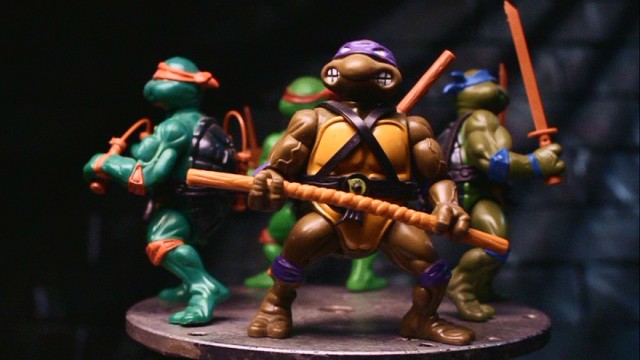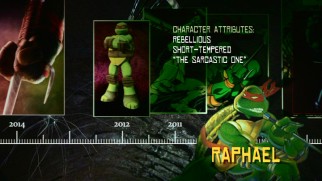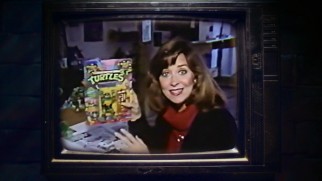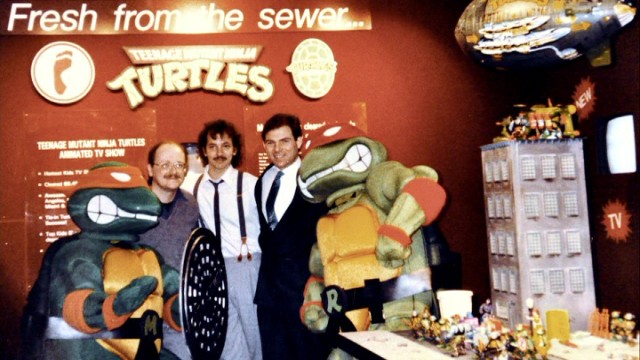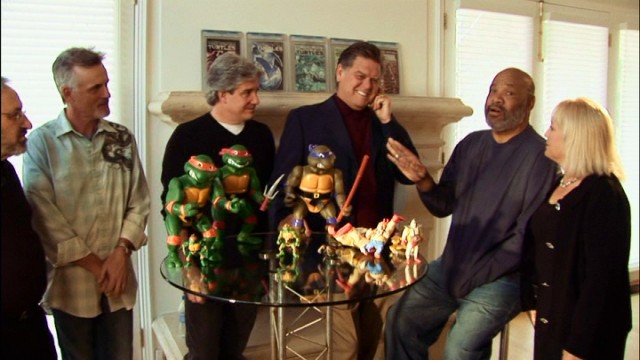Turtle Power: The Definitive History of the Teenage Mutant Ninja Turtles DVD Review
Buy Turtle Power on DVD from Amazon.com
A new movie titled Teenage Mutant Ninja Turtles opened in nearly 4,000 theaters across North America today. Hailing from producer Michael Bay (the Transformers series), director Jonathan Liebesman (Battle: Los Angeles, Wrath of the Titans), and screenwriters of Mission: Impossible - Ghost Protocol and Divergent, Turtle Power: The Definitive History of The Teenage Mutant Ninja Turtles, a new documentary premiering on DVD from Paramount next Tuesday, starts at the very beginning, recalling the modest origins of Raphael, Donatello, Michelangelo, and Leonardo. The weapon-wielding, half-shelled green brothers would be household names throughout the world by 1990, but they first came to life in a little 1984 New Hampshire comic given a 3,000 print run with financial help from family members. Eastman and Laird, the most important of countless individuals interviewed here, remember they had no real vision for the characters, whose primary villain was killed off in this premiere issue. The local reception was strong enough to warrant a second issue with a print count rising to five figures, which was enough to get Eastman and Laird to quit their jobs and become full-time comic book artists.
Well, perhaps not quite full-time. Their early days at Mirage Studios, seen in fitting, valuable home movies, are playful ones, with leisurely activities interrupted only by the occasional work break. Demand for the comic continued to rise, but it was not until they hooked up with Surge Licensing that the Turtles entered the mainstream. Mark Freedman, who leaves his businessman switch turned on during his interview, reflects on getting Eastman and Laird to agree to a short-term deal and seizing the opportunity to wow them.
Freedman got the ball rolling at Playmates Toys, who would develop a line of action figures in conjunction with a television series. Without hesitation, producer Fred Wolf and screenwriter David Wise, already a fan of the comics, got to work on a five-episode animated origin story for the Turtles. The documentary devotes plenty of time to both the figures and the animated series, gathering insight from many pertinent parties, from original sculptor Steve Varner to more than a half-dozen leading voice actors (including late "Fresh Prince" uncle James Avery, the voice of Shredder). We hear about efforts to distinguish the characters both visually and by personality and learn the origin of "cowabunga" as a catchphrase (inspired by a 1960s Peanuts strip of Snoopy surfing).
From there, we move to the next big frontier: feature films. Producer Thomas Gray and story writer Bobby Herbeck describe the resistance their respective pitches met and the challenges faced once the backing of Golden Harvest, a Hong Kong company seasoned in martial arts, was secured. Many speak fondly of the original 1990 live-action film, especially acknowledging the input of director Steve Barron and Jim Henson. Henson's son Brian, the film's chief puppeteer and second unit director, and others reveal the assorted technical challenges faced, from the cumbersome nature of the Turtles' suits to the breakdown-prone animatronic faces. And yet, everyone seems positive about the experience, from actress Judith Hoag (April O'Neil) to Splinter puppeteer Kevin Clash (the longtime voice and performer of Sesame Street's Elmo) to Michelan Sisti, who wore the heavy Michelangelo suit. We're even treated to outtakes, deleted scenes, and behind-the-scenes from this lucrative production.
While Turtle Power could have segued straight into the hasty sequels, which were subjected to the usual diminishing returns and aren't very well-regarded, it wisely instead chooses to celebrate the impact of the franchise at large, which has far exceeded the three-year lifespan anticipated as a best-case scenario back when Eastman and Laird were developing their comic book series into a toy line (there are even priceless video clips of a meeting at Playmates). Thirty-something fans voice their enduring appreciation of this universe. Spin-offs like video games and a successful live concert show that sold out Radio City Music Hall before embarking on a nationwide tour are given their notice. One of the highlights of the film is "The State" alumni Michael Ian Black and Robert Ben Garant separately reminiscing about dropping out of high school to don the Turtles suits for promotional purposes, each detailing their unforgettable experience of appearing before a sea of enthusiastic children in Juarez, Mexico in advance of a Texas show.
The two early '90s live-action sequels are briefly touched upon without mincing words and the documentary then looks to use the dissolution and falling out of Eastman and Laird to provide its conclusion. Eastman explains signing over creative control to Laird, who recalls his 2001 revival comic being received poorly and laments the loss of their fruitful collaboration. Skipping over subsequent TV incarnations, the 2007 CG-animated film, and the brand new reboot completely, Turtle Power ends with the co-creators reuniting for the first time in nearly 20 years at a 30th anniversary signing this past May. Music flares to emphasize the happy note, but the rift has been dealt with too briskly and as an afterthought to pack the emotional punch intended.
In spite of that closing miscalculation, Turtle Power does an admirable job of living up to his bold subtitle. It's unclear how Randall Lobb, a high school English teacher in Ontario, was able to make this his filmmaking debut as lone writer-director or how he was able to get Paramount to release it to DVD in close proximity of the major new movie's release. But Lobb succeeds at talking with as many relevant parties as he can and giving this pop culture franchise proper notice and perspective. I can only imagine how excited I would be if someone else applied Lobb's authoritative treatment to a franchise I feel more passionately about, like The Muppets or Ghostbusters.
Such an undertaking seems more conducive to passionate fans who wind up with unfunded Kickstarter projects, YouTube copyright violation notices, or an insufficient documentary should they play things too safe or be unable to afford a legal department for clearances. Lobb somehow avoided all that and brings this movie to a wide audience on Tuesday with the backing of one of the biggest studios out there, its Amazon sales rank already at a most impressive low four figures.
VIDEO and AUDIO
Turtle Power is treated to 1.78:1 anamorphic widescreen picture and full Dolby Digital 5.1 sound, things it's easy to imagine a smaller studio not giving it. The video is obviously limited by source, with nearly 30-year-old home movies understandably lacking in clarity. The newly-shot material looks pretty sharp, though, BONUS FEATURES, MENUS, PACKAGING and DESIGN
Outside of award season screeners, this is one of the most barren DVDs I've encountered.
A Previews section repeats the trailers which play automatically at disc insertion. They promote the new Teenage Mutant Ninja Turtles movie, DVDs of Nickelodeon's current "Teenage Mutant Ninja Turtles" series, Transformers: Age of Extinction, and Hercules.
The static, silent main menu adapts the cover art, placing listings as speech bubbles coming out of the Turtles' mouths.
Unsurprisingly, no slipcover and nary an insert join the black Eco-Box keepcase holding the plain gray disc.
CLOSING THOUGHTS
As promised by its subtitle, the comprehensive and professional Turtle Power does provide a definitive history of the Teenage Mutant Ninja Turtles. Randall Lobb's documentary is a loving tribute to the turtles and those who have brought them to life in various mediums. While it might be better appreciated as a bonus feature on one of the movies ($20 is a lot to pay these days for a completely barebones DVD), it has enough value to justify this standalone release. Turtle fans are not likely to be disappointed by this exhaustive and insightful effort.
Support this site when you buy Turtle Power now on DVD at Amazon.com
|
Related Reviews:
DVDizzy.com | DVD and Blu-ray Reviews | New and Upcoming DVD & Blu-ray Schedule | Upcoming Cover Art | Search This Site
DVDizzy.com Top Stories:
TMNT (2007) • Henson's Place: The Man Behind the Muppets • Waking Sleeping Beauty • The Tick vs. Season 1
Freakazoid! Season 1 • Dinosaurs: The Complete First and Second Seasons • The Pixar Story
New to Blu-ray: Bears • Woodstock: 3 Days of Peace & Music (40th Anniversary Revisited) • The Unknown Known
Text copyright 2014 DVDizzy.com. Images copyright 2014 FauxPop Media, iProductions, and Paramount Home Media. Unauthorized reproduction prohibited.
